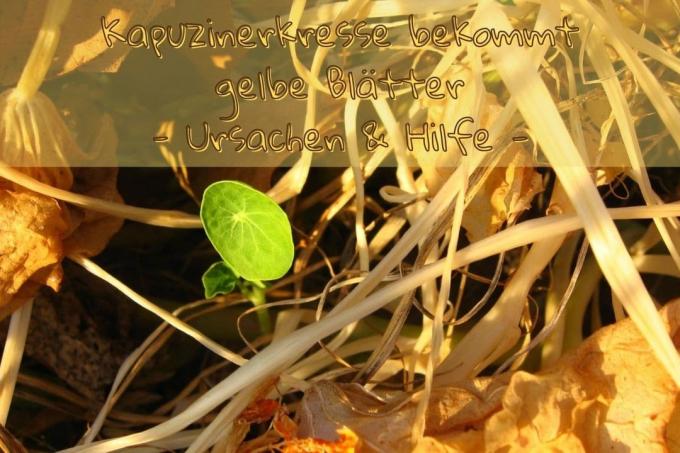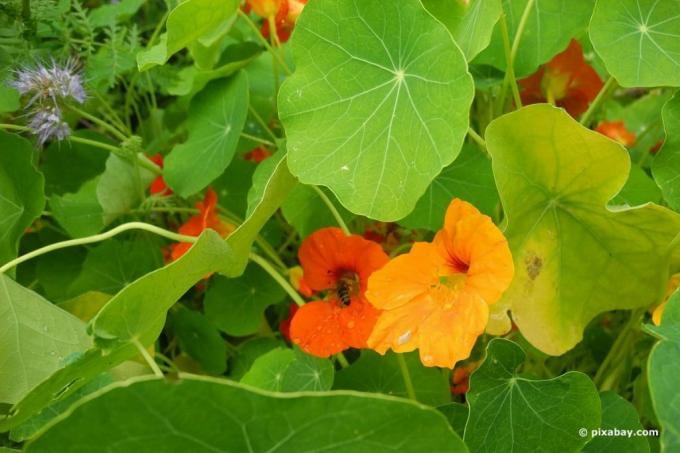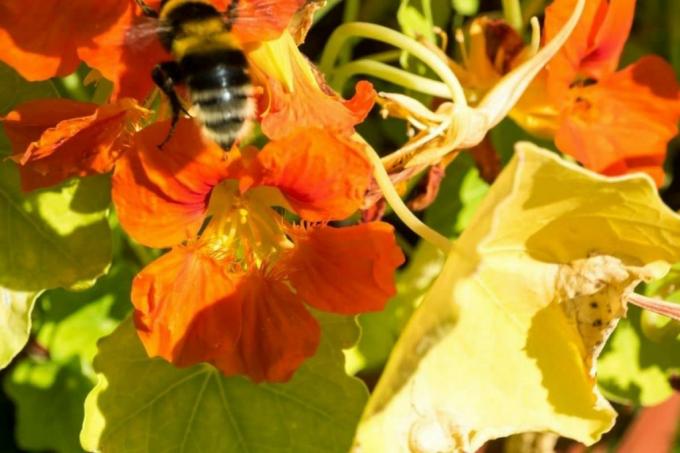
table of contents
- Natural aging process
- Water supply
- Too much fertilizer
- Aphids
- frequently asked Questions
Single yellow leaves on the nasturtium are normal. If more and more leaves are discolored, this is an alarm signal that it is the plant not going well. Simple measures bring the color back.
In a nutshell
- a few yellow discolored leaves are a normal aging process
- Check for possible causes only when there is an accumulation of yellow leaves
- too much or too little water can lead to yellow leaves
- if over-fertilized, the leaves turn yellow
- Pests like aphids can lead to yellow leaves
Natural aging process
The nasturtium (Tropaeolum) is now available in different versions as Ground cover or climbing plant. It shows its yellow to orange flowers from around June until frost. During this time the foliage should also be nice and green. However, it can happen that it has individual yellow leaves. This is not yet a warning sign, but part of the natural aging process of the plant. Older leaves die off as it takes too much strength for the plant to maintain them. Even leaves that get too little light or are damaged, the plant separates from them and they turn yellow and eventually fall off.

Note: You can support the plant by removing leaves that are starting to turn yellow near the stem. The plant therefore has to invest less energy in this degradation process.
Water supply
There are many reasons why the leaves turn yellow. The most common reason is the supply of water. Nasturtiums react to both too much and too little water with yellowish discolouration of the leaves. It is easy to tell whether there is too much or too little water. If there is too much water, the leaves in the lower area are more likely to be the first to discolour. The leaves in the lower area are also at greater risk from too much water that infections such as mold can develop there.
If the yellow leaves result from a lack of water, you can recognize this by the following characteristics:
- yellow leaves in the upper area (shoot tips)
- Leaves hang limply
- Leaves partially curl up
You can easily prevent water shortages or a water stagnation when planting. To do this, mix the soil with clay granules or expanded clay. This loosens the soil, but at the same time can also store water very well, which is gradually released into the environment.
Too much fertilizer
The nasturtium often reaches impressive sizes, which is why many hobby gardeners suspect that it has high nutritional needs. Although it needs nutrients and more than herbs usually need, it is not a heavy eater. In terms of consumption, it is more in the lower range of the average consumption. Too much fertilizer, however, causes the leaves of the nasturtium to turn yellow and shed them.
If the yellow leaves result from over-fertilization, proceed as follows:
- Stop fertilizing immediately
- water more, but do not cause waterlogging
- if possible, transplant to a less nutrient-poor location

Watering is a simple means of reducing the concentration of nutrients in the soil. However, you should pay attention to the right time here. The right time to water is late in the morning. At this point in time, the risk of waterlogging is low, because the sun dries out the soil again over the course of the day.
Tip: If the nasturtium is grown in a pot, simply swap the substrate. Make sure that you remove as much of the over-fertilized substrate as possible without damaging the roots too much.
However, you must not completely do without nutrients, otherwise yellow leaves can form due to an undersupply. If you are planting the nasturtiums in the spring, mix a substrate with a medium concentration of nutrients. This consists of the following parts:
- 3 parts of garden soil
- 2 parts compost soil (sieved)
- 1 part sand
Many are tempted to take additional care of the nasturtiums by adding liquid fertilizer. However, this should largely be avoided. Above all, you must not use fertilizers that have a high nitrogen content. You can work in a maximum of a little compost around the plant during the season.
Aphids
Although nasturtiums are well protected from diseases and pests by their ingredients, they are not entirely spared. A common problem with these plants is aphids. They are usually particularly difficult to discover or are not found for a long time, as the large, round leaves provide optimal privacy for the lice.
The lice injure the leaves with their mouthparts. The plant can still compensate for a few places; if the infestation is severe, the leaves change color and are then thrown off. However, this is often a vicious circle, in which case the aphids crawl back onto the plant and continue to cause damage there.
You can easily fight this:

- Remove severely infected leaves and dispose of them in the residual waste
- Wash off lice with a soft soap solution (1L water and 2 tablespoons curd soap)
- Promote beneficial organisms such as ladybugs
- Strengthen the epidermis of the plant with manure (field horsetail)
Tip: Occasionally look at the underside of the leaves. In this way you can discover early on whether aphids have attacked the plant.
frequently asked Questions
Not every manure has a high content of nitrogen. Field horsetail strengthens the plant's epidermis but is low in nitrogen. As an alternative to liquid manure, you can also use broths or teas that contain little or no nitrogen.
In the short term, nasturtiums cope well with drought. If the dry phase lasts for a long time, they should be watered thoroughly every three to five days.
No, neither cutting off the flowers nor the leaves promotes yellowing. Only remnants of leaf and flower stalks turn yellow and fall off. Therefore, you should always remove leaves and flowers close to the main shoot.
